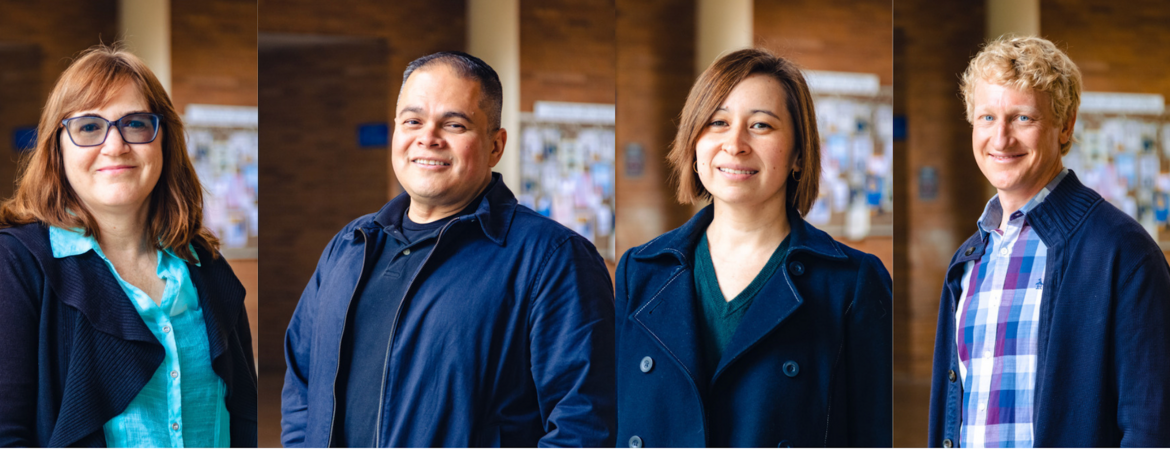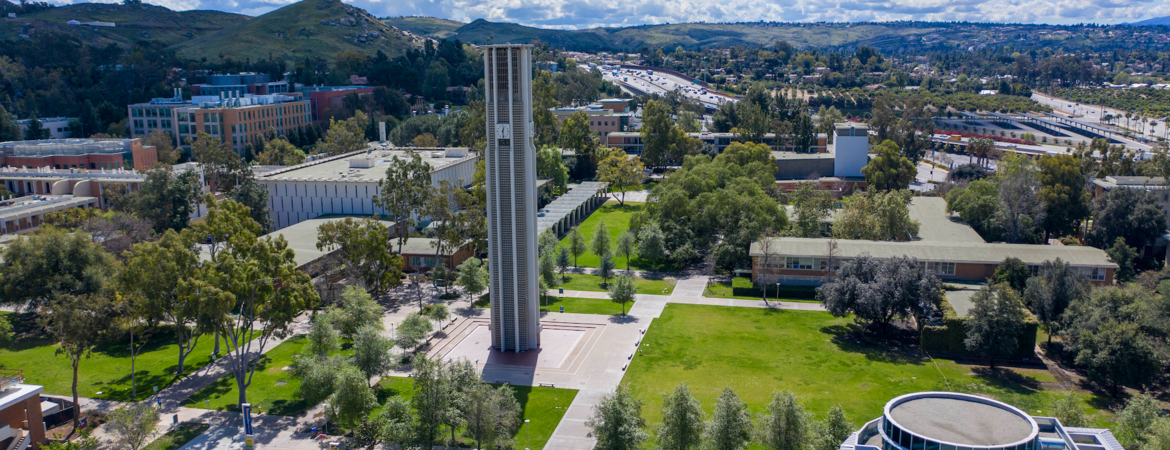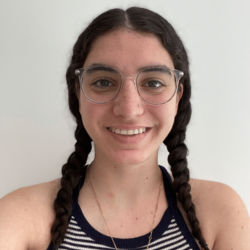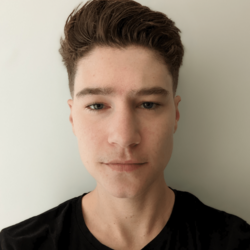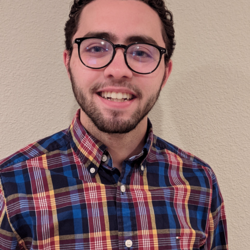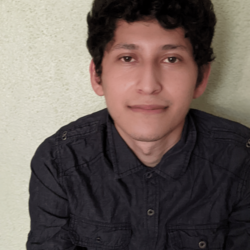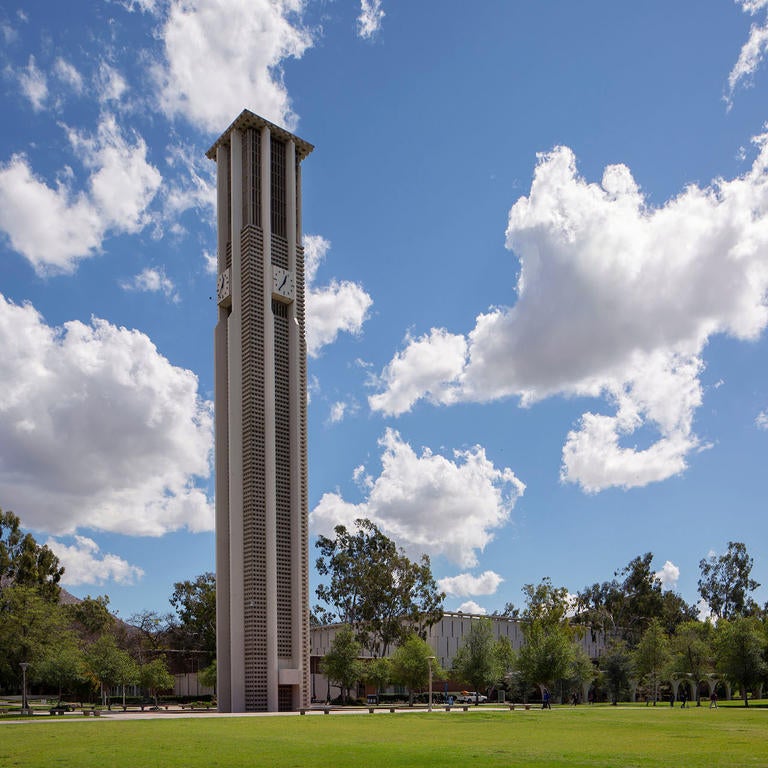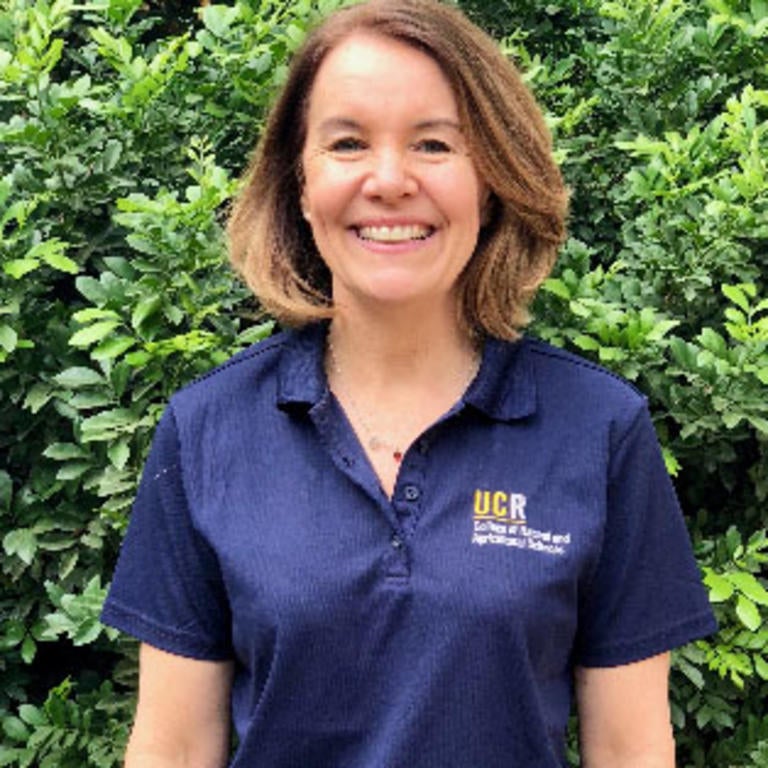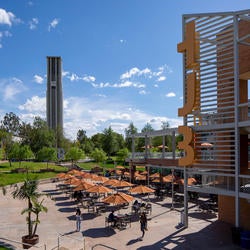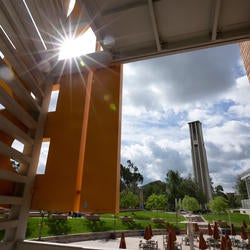Welcome to the 2022 MSRIP Symposium
August 12, 2022 9:00 am - 5:00 pm
at the UCR Alumni Center (map)
Download the Official Program Here
9:00 - 9:15 - Opening Remarks
9:15 - 11:30 - Oral Presentations Session #1
12:00 - 2:15 - Oral Presentations Session #2
3:00 - 3:45 - Poster Presentations
4:15 - 5:30 - Dinner
Oral Presentations
Please click on the name below to see the student's picture and read their abstract
-
9:00 - 9:15 - Welcome/Opening Remarks
Welcome from Shaun Bowler, Grad Division Dean
-
9:15 - 9:30 - Will Cruz, Chemistry, Cal Poly Pomona
Faculty Mentor: Dr. Nicholas DiPatrizio, School of Medicine
Cholinergic control of orexigenic endocannabinoids in intestinal epithelium and blood of diet-induced obese mice
Obesity is correlated with pathologies such as heart disease, diabetes, and some cancers. The biomolecular systems implicated in obesity are important to study, as a better understanding may allow for improved preventative measures and treatment. The cholinergic system (CS) and the endocannabinoid system (ECS) together are of interest as the CS is one of the pathways upstream of the ECS. Both systems have been shown to be dysregulated in obesity. For example, increased concentration of the endocannabinoid 2-arachidonoyl-sn-glycerol (2-AG) in the intestinal epithelium of diet induced obese (DIO) mice drives hyperphagia via activation of local cannabinoid receptor subtype 1 (CB1R). In the CS, the efferent vagus nerve releases acetylcholine, activating Gq coupled muscarinic acetylcholine receptors (mAChR) in the gastrointestinal tract, and in turn, stimulates increases in production of 2-AG. An overall goal for the current study is understanding if mAChRs control intestinal endocannabinoid (EC) formation in diet-induced obesity. Previous studies in the DiPatrizio lab have shown that various mAChR antagonists blocked the formation of 2-AG and its precursor 1-stearoyl-arachidonoyl-sn- glycerol (SAG) in the intestinal epithelium of DIO mice. Levels of 2-AG, SAG and other analytes where quantitated using UPLC-MS/MS. Now, we are investigating whether treatment with an m3-specific mAChR antagonist (DAU-5884), an m1-specific antagonist (pirenzepine), and the non-selective peripherally-restricted mAChR antagonist, atropine, will block the formation of EC in blood in DIO mice. These studies will aid in the design and development of therapeutic strategies that target the CS and EC system for the treatment of obesity and related metabolic disorders.
-
9:30 - 9:45 - Ivy Nicole Mejia, Psychology
Faculty Mentor: Weiwei Zhang, UCR Department of Psychology
Cognitive Processes for Mammographic Detection of Breast Cancer
A fundamental element of breast cancer research and treatment is understanding how radiologists read and interpret mammograms. This project aims to explore the cognitive mechanisms associated with global versus focal cancer signals in mammograms that medical experts (e.g., radiologists/mammographers) use in mammogram reporting. Specifically, the radiology experts versus gastrointestinal experts as the control group will view serially presented mammogram images for 500 milliseconds and then 2.5 seconds and make abnormal versus normal decisions on each presentation. The task performance will be analyzed using a computational approach (i.e., hierarchical Bayesian model) to estimate the amount of global versus focal processing. It is hypothesized that radiologists can extract global gist information to detect the abnormality in mammograms prior to identifying the focal sign of abnormality. Through the findings of this study, medical error and missed diagnoses, the most common causes of radiology litigation, can be potentially reduced by recognizing the specific causes and subsequently reducing them. Furthermore, by modeling human mammogram reading performance, artificial intelligence can be used to develop computer-aided detection tools.
-
9:45 - 10:00 - Rena Perez, Linguistics
Faculty Mentor: Dr. Jan Blacher, School of Education
Services and Resources Accessed in High School by Students with and without Intellectual and Developmental Disabilities (IDD)
Researchers have recommended that youth who have experiences with employment or with accessing services are better prepared for the transition to adulthood (Roberts et al., 2010; Snell-Rood et al., 2020). Therefore, it is important to consider the resources available to youth, especially those with disabilities, before they exit high school (HS). This study will look at the sources of support available to youth with and without IDD during high school and compare sources of support utilized across the two groups (neurotypical vs IDD). Responses to an open-ended interview question regarding services and resources that helped the youth transition out of HS will be analyzed using thematic analysis.
Initial codes were separated into two categories: Type of Support received during HS and the Source of Support (i.e., who provided the support). Preliminary data from 18 out of 111 interviews (17 moms; 1 dad) were coded. The top four reported Types of Support were: Social Support (19%), Transition-Specific Preparation (15%), Executive Functioning (15%), and Lack of Support (15%). Sources of Support most frequently reported were provided by the young adult’s parent (38%), the high school (24%), young adult (24%), and service systems (10%). Findings suggest that all types of support are important for facilitating the transition to adulthood for all youth. These findings also provide insight into the barriers (such as a lack of support, particularly from schools) that need to be broken down to better support those with and without intellectual and developmental disabilities during their transition into adulthood.
-
10:00 - 10:15 Juan Rojas, Mathematics
Faculty Mentor: Qixuan Wang, UCR Department of Mathematics
Modeling of the Fibroblast Chemotaxis During Hair Follicle and Feather Bud Formation
Chemotaxis is the process of cells migrating to attractant chemicals or away from repellents. Chemotaxis is seen all over biology, including the formation of hair follicles and feather buds during embryonic developments, when dermis fibroblasts are attracted by and migrate to chemical signals. The proper development of hair follicles and feather buds are important to humans and animals for a variety of reasons, for example, to stay warm, and protect the body. We develop a mathematical model on hair follicle development based on previous published work. The model we use is a type of partial differential equations, known as Patlak-Keller-Segel (PKS) equations. We use a combined finite volume and finite difference method to numerically solve the PKS equation.
-
10:15 - 10:30 - Betsy Centeno, Psychology
Faculty Mentor: Dr. Diamond Bravo, UCR Department of Psychology
The Role of Family and Community Relationships on Cuban Medical Students’ Adjustment
There is a growing need to recruit individuals from underrepresented groups into the medical field. Prior work with underrepresented communities has demonstrated that support systems may support the transition to medical school. Limited work has investigated the role of culturally salient support from families and communities. Guided by a community cultural wealth model, the current study focused on the following research questions; 1) How does the relationship between medical students and their family and community change during medical school? 2) How might changes in family and community relationships differ by gender?
This study used data from the Cuban Medical Student Motivation Project. The study included 886 participants (53.3% female; 24.3% Black, 23.5% Mestiza, 52.2% White) from 5 Cuban medical schools. Using a mixed method approach, we conducted a thematic analysis to identify emerging themes related to changes in family and community support across the transition to medical school. Overall, 37.6% of medical students reported that community relationships improved, 33% reported family relationships improved, 3.6% community worsened, and 2.93% said their family relationships worsened. Additionally, 60.5% of females reported that their family relationships improved, compared to 39.5% of males. Moreover, 57.1% of females reported improved community relationships, compared to 43% of males. Inter-rater reliability ranged was approximately 82% across themes. Various themes emerged specifying how family/community relationships changed during medical school. Findings have implications for the role of community and family support on medical students’ success in medical school.
-
10:30 - 10:45 - Alexander Nguyen, Cell, Molecular, Developmental Biology
Faculty Mentor: Dr. Rachel Wu, Department of Psychology
The onset of COVID-19 exacerbated the digital divide and barriers individuals in low-income and high-assistance situations may face. Recent studies related to the pandemic have attempted to resolve the dilemma of quality of life and cognitive functioning with the elderly. The present study provided low-income older adults with internet access, tablets, IT support, and personalized training during a 12-week intervention with Riverside County’s Office on Aging. The goals of this project were to improve cognitive functioning, increase growth mindset, and decrease loneliness through increased exposure and training with these tablets. Participants totaled 19 older adults (15 females, 57% Caucasian, 26% Hispanic) across two waves. To measure changes in cognition, we over-the-phone assessments and well-being questionnaires. T-tests comparing pre-and post-test scores indicated no significant change for feelings of loneliness and cognitive scores but did reveal a significant increase in the growth mindset.
However, future studies on a larger scale could yield different results. As a result, these findings could inform public health and policy services to address barriers to access, reduce cognitive decline, and improve psychological and physical health.
-
10:45 - 11:00 - Gerardo Michel, Psychology
Faculty Mentor: Elizabeth Davis, UCR Department of Psychology
How Does Children’s Negative Emotion Differentiation Relate to Emotion Regulation and Psychopathology?
Emotion differentiation, the extent to which people experience emotions as being distinct from one another (e.g., sadness versus fear), is thought to influence emotion regulation. Less work has investigated how it may be linked with the development of mood-related internalizing psychopathology (i.e., depression and anxiety). To address this gap, the current study investigated whether negative emotion differentiation was associated with a) children’s self-reported use of emotion regulation strategies and b) children’s parent-reported symptoms of psychopathology. Data were collected from 106 seven- to 11-year-old children (59 boys, M age = 9.3). Emotion differentiation scores were computed as the variance in self-reports of experienced negative emotions across multiple timepoints. Measures involved (1) interviews about children’s specific emotion regulation strategies, (2) a resting psychophysiological measure of emotion regulation capacity, and (3) children’s anxiety and internalizing symptoms. Results indicated that negative emotion differentiation was not associated with psychopathology, but differentiation was higher for children who did not use cognitive reframing than for children who did. Negative emotion differentiation was positively associated with separation anxiety for children who did not use social support seeking strategies. Additionally, resting physiology was found to have a protective effect against some facets of psychopathology based on the specific regulation strategies children used. These results provide evidence for the presence of some associations between negative emotion differentiation, emotion regulation, and developing psychopathology in children. This project highlights the need for more research investigating the role of emotion differentiation in regulation
strategy use within the context of child psychopathology.
-
11:00 - 11:15 Sofia Hernandez, Education
Faculty Mentor: Dr. Covadonga Lamar Prieto, Department of Hispanic Studies
Study on Dual Immersion Programs: A Case Study on the Transition between Dual Language Immersion to Mainstream Classes
Dual Language Immersion (DLI) programs have been used since the 18th century across the U.S., however recent changes in education policy and political views resulted in bilingual education losing importance (Pavlenko, 2002). Previous research shows that students who are placed in English-only programs do not perform as well as their counterparts in DLI (Collier & Thomas, 2004). The majority of this research is often conducted using quantitative methods including test scores, grade averages, and reclassification rates ignoring student experiences.
Marian et al. (2013), has proven for the last 20 years that DLI programs work in elementary schools. My project adds to the current understanding of newcomer (incoming immigrant students) English Learners (EL’s) by providing insight on students' experiences of a DLI program and how their transition into mainstream classes compares. I will focus on Castle View Elementary and DLI student transition to Sierra Middle School. The purpose of this study is to take into consideration the opinions and experiences of students.
I will use a longitudinal study to see how DLI plays a role in these students’ lives and how it has changed with the lack of the program, if it has at all. I will collect qualitative data, over the span of one full year (June 2023 to June 2024), using interviews and surveys along with the use of the ELPAC (English Language Proficiency Assessments for California) to track their language acquisition. Students who are interviewed will be those who were considered newcomers and are in their last month of 6th grade DLI moving into 7th grade mainstream classes. I hypothesize that students will express preparedness to be in mainstream classes however, feel less supported compared to the DLI program.
-
11:15 - 11:30 - Veronica Sanchez, Anthropolgy
Faculty Mentor: Francesca Hopkins, UCR Department of Environmental Sciences and Chikako Takeshita, UCR Department of Gender and Sexuality Studies
Extreme Heat Affecting Groundskeepers at the University of California, Riverside
Honorable but taxing, outside workers are exposed to harsh environmental conditions that make them more susceptible to heat related illnesses. As climate change worsens so does the likelihood of extreme heat events. There are certain adaptive measures that we must take in order to establish safe working conditions in our immediate future. Riverside already experiences extreme heat, with temperatures often exceeding state and university criteria for possible heat risk. Here, we will investigate how campus landscape workers are affected by high temperatures, how climate change may worsen the situation, and what measures can be taken to reduce the risk they face working under high heat conditions.
Alongside UC campuses like Merced, UC Riverside experiences some of the harshest summer heat temperatures and possible heat illness exposure. This is why although UCR follows the UC and California State regulations it is essential to assess current outside worker regulations and determine whether or not they will be sufficient as temperatures rise. This research project will examine current University of California, Riverside guidelines and regulations in order to find out how the current adaptation to extreme heat events on the job is affecting groundskeepers and find out from them if there are improvements that can be made in their working conditions.
Using an interdisciplinary approach and working alongside UCR professors of environmental science, labor studies, and gender and sexuality studies as well as other professional UCR staff. We will generate climate projections to help us understand how temperatures will change in the future over the next 10 years. We will examine the current UCR guidelines to determine if adjustments may be necessary based on the forecast. In addition, we will survey groundskeepers to find out how they feel about these current regulations and whether or not they are sufficient for them to comfortably work during the summer. We recommend solutions that could be possibly implemented now or in the future.
-
11:30 - 12:00 Break
Break
-
12:00 - 12:15 - Taylor-Ann Robinson
Faculty Mentor: Dr. Aerika Loyd, UCR Psychology Department
Identifying Key Components of Gut Dysbiosis Research for Potential Neurological and Psychiatric Interventions
Researchers are studying the gut-brain connection to understand neurological and psychiatric disorders. Gut microbiome imbalance (i.e., dysbiosis) has been implicated metabolically in pathogenesis for its inflammatory, toxic, deregulatory, and degenerative effects. Neurological and psychiatric disorders often include degrees of inflammatory and oxidative stress, and irregular immunological signaling and genetic expression, like gastrointestinal disorders. As disorder incidence rates and treatment demands continue to increase, the biomedical community remains in the theoretical and trial stages. While previous research has focused on specific biological mechanisms, pathways, and interventions, this comprehensive study compilates the most recently discovered and common components of published findings. To advance the literature, this systematic review analyzed 30 recent dysbiosis studies and identified the most promising components and their contextual applications within neurological and psychiatric research. Articles were reviewed and selected via criteria inclusion methods that called for adult populations; associations between dysbiosis and mental disorders; and/or context on functional, structural, and molecular mechanisms, treatments, and screening methods. Subsequently, components involved in risks (e.g., pre/neonatal microbial integrity, diet, genetics), biomarkers (e.g., inflammatory cytokine level, epithelial permeability, endotoxemia), screening methods (e.g., fecal analysis, microbial and genetic sequencing, neuroimaging), and treatments (e.g., fecal transplantation, prebiotics, diet) were stratified. Results implied prenatal factors, genetic mutations, lifestyle (e.g., diet, smoking, drug use, sleep, oral hygiene), and age were most implicated in dysbiosis. Additional risk factors included environment (e.g., geographical microbial integrity) and stress. Additionally, recommendations on future approaches and practices were identified. This study serves as a catalyst for potential psychiatric and neurological interventions.
-
12:15 - 12:30 - Kemani Hunter, Psychology, U of the District of Columbia
Faculty Mentor: Dr. Carolyn Murray, Department of Psychology
Potential Environmental Antecedents of Self-handicapping
Self-handicapping strategies are coping mechanisms meant to protect one’s self-esteem by projecting potential failures onto external factors (e.g., task difficulty), while in the case of success it should augment one’s belief in their own ability. The existing research asserts that self-handicapping is driven by anxiety, uncertainty, and specific personality traits, such as conscientiousness and neuroticism. However, there may be more factors involved that have yet to be investigated. The current factors reflect the inner workings of one’s mind, but they fail to illustrate how one’s environment affect their inclination to self-handicap. This study examines potential environmental antecedents of self-handicapping (e.g., high school college-going culture), and compares their relationship to internal variables. 316 undergraduate students completed surveys measuring internal variables (such as the Big 5 personality, growth mindset, one’s self-esteem, and one’s self-efficacy), and external variables (such as college-going culture, everyday discrimination, support from significant others, etc.). Consistent with previous studies, the results indicated that beliefs about the self (e.g., self-esteem, self-efficacy, etc.) predict the extent to which one self-handicaps. Additionally, growth mindset was found to have a negative relationship with self-handicapping. The external factors although not as strong, familial support as predicted, resulted in a significant negative relationship with self-handicapping, and everyday discrimination resulted in a significant positive relationship with self-handicapping. These findings are important, as they provide insight on the type of environmental factors that positively support self-esteem while also illuminating negative contributors of self-handicapping.
-
12:30 - 12:45 - Liana Willis, Psychology/Law and Society
Faculty Mentor: Dr. Aerika Loyd, UCR Department of Psychology
An Evaluation of Evidence-Based Mental Health and Wellbeing Interventions for Youth Who Have Experienced Domestic Violence
The objectives of this project are to examine key and common features of effective interventions for children exposed to domestic violence, as well as to compare effective and partially effective programs. Exposure to domestic violence is operationally defined as receiving or witnessing physical abuse at home. We conducted a systematic literature review to identify articles. To be included in the analysis, programs had to be for youth (ages seven to seventeen) who have experienced domestic violence, evidence-based, in the United States, and completely or partially effective at improving their mental health or wellbeing. Programs were considered effective if they resulted in improvements to all intended aspects of participants’ mental health and wellbeing. Programs were considered partially effective if they accomplished some, but not all intended improvements. Using these criteria, we selected 10 programs. Results indicated that cognitive-behavioral therapy and recruiting participants who experienced abuse recently, are common and potentially key features of effective interventions of this nature. Interventions that incorporated caregivers and youth together seemed to be the most effective. In our discussion, we offer recommendations for future research including investigating differences between programs that incorporate caregivers and those that only work with youth, as well as further study of less common intervention approaches such as mentorship.
-
12:45 - 1:00 - Shamed Amani, Biology
Faculty Mentor: Scott D. Pegan, Division of Biomedical Science, School of Medicine, University
of California, RiversideFinding Binding Affinity of Different Papain-Like Proteases and Viral Ovarian Tumor Proteases to
Interferon Gene Product 15 from Different SpeciesInterferon Gene Product 15 (ISG15) is a critical regulator of the host immune response by
binding with response proteins in a process called ISGylation, subsequently initiate the type 1
interferon response (IFN-1). However, nairoviruses, like Crimean Congo Hemorrhagic Fever
Virus (CCHFV), along with coronaviruses, bypass this host immune response by cleaving host
and viral ISGylated proteins. ISG15 is also conserved in animal species, but the amino acid
sequence varies widely among those different species, including in mammals. The amino acid
difference may lead some species ISG15 not to be cleaved by the nairovirus or coronavirus.In this study, ISG15s belonging to a variety of different species were obtained and analyzing
regarding its binding affinity against papain-Like proteases (PLPro), from coronaviruses, and
viral ovarian tumor proteases (vOTUs), from nairoviruses, CCHFV and the Kupe virus (KUPV),
both of which have deISGylating properties.The proteins were developed using bacterial transformation with DNA constructs on T-7
expressing E. coli. The protein was then isolated through chromatography and the binding
affinity was analyzed using a Bio-Layer Interferometry (BLI) instrument. Additionally, utilizing
the excess protein from this process, attempts to obtain the crystals for further follow up
structural studies of diverse ISG15 were pursued. With this information, a new molecular
biological tool can be fashioned that will allow animal reservoirs of coronavirus and nairovirus
along with other viruses that engage ISG15s such as Influenza B to be rapidly identified. This
will assist in pinpointing the origin of outbreaks as well as direct resources to hinder spread of
these viruses. -
1:00 - 1:15 Winy Chen, Biology
Faculty Mentor: Scott D. Pegan, Division of Biomedical Science, School of Medicine
Identifying cellular targets of Crimean-Congo Hemorrhagic Fever Virus vOTU
Crimean-Congo Hemorrhagic Fever Virus (CCHFV) is a tick-borne virus widespread in Africa, parts of Asia and Europe. With death rates ranging from 10% to 40%, and no currently approved vaccine or treatments available, there is an urge in finding molecular targets that could lead to the development of such therapeutics.
The CCHFV RNA L-segment (L-protein) encodes for a RpRd and a viral ovarian tumor (vOTU) protease at N-terminal. Several studies have shown that the vOTU possess deubiquitinase (DUB) and delSGylase activities, impairing the host innate immuneresponse by reversing post-translational modifications initiated by the cellular ubiquitin (Ub) and the interferon-stimulated gene product 15 (ISG15), essential for type 1 interferon (IFN1) response.
The goal of this study is to use a proteomic approach to narrow down the subset of cellular proteins interacting with ISG15. Human cells ISG15 deficient (A549 KO) will be transfected with plasmids encoding the CCHFV L-protein or vOTU wild type (and its catalytically inactive versions) together with V5-tagged human ISG15 (V5-hISG15). IFN1 response will be stimulated by adding synthetic RNA (Poly I:C) which mimics a viral infection. The host proteins conjugated with V5-hISG15 will be isolated using magnetic beads conjugated with anti-V5-tag-MAbs and analyzed by mass spectrometry, considering protein total abundance and cellular function. Through this work, host proteins and pathways that CCHFV needs to evade will be revealed. Thus, revealing new targets for therapeutic intervention.
-
1:15 - 1:30 - Stacy Lopez, Sociology
Faculty Mentor: Adalberto Aguirre, UCR Department of Sociology
The Impact of the Southern Border on Educational: Support, Punishment and Achievement
While education is nationwide right to children, a student’s experience varies based on where they live. This is evidently true with the Hispanic, Latinx community living at the border. Many studies have been focused on a national level, explaining the threat of anti-immigrant sentiments on immigrant students or the children of immigrants but not much has been focused on these communities at the border. This literature review focuses on border schools and how the Southern border impacts educational support, punishment, and achievement. Support comes in the form of culturally relevant teachings such as dual language programs and the crucial support from leadership. Commitment and validation of the students and their families' culture and communities is thus formed, impacting the rates of student punishment in these schools which can lead to educational achievement through the form of higher education and social mobility. The central focus of this study may be the Hispanic/Latinx community, but these studies can serve as a basis for support for the advocacy of culturally relevant teachings to address and support immigrant communities nationwide.
-
1:30 - 1:45 - Karina Zepeda, Psychology and Sociology
Faculty Mentor: Adalberto Aguirre Jr, UCR Department of Sociology
A Framework of Resistance and Resiliency: Transforming University Settings into Sites of Accessibility and Inclusion to Support Undocumented College Students
Prior literature has consistently demonstrated the resiliency of undocumented college students as they navigate institutions of higher education. However, there continues to remain scarcity in the theoretical and practical approaches to creating systemic changes in university settings to promote undocumented students success. This paper seeks to address this gap, by proposing a theoretical framework informed by prior literature that identifies forms of resilience, best practices when working with undocumented students in higher education, and draws on examples of participatory action research with undocumented students. With regard to resilience, this is conceptualized as essential acts of resistance that undocumented college students use to cope with their status and higher education. The literature on diversity, equity, and inclusion is referenced to identify best practices that are used when supporting undocumented students. In the final dimension of the model, participatory action research strategies used with undocumented students are included. Participatory action research is an experiential methodology that directly involves communities as co-researchers to derive solutions to the issues that are most impacting their livelihoods. From incorporating each of these core dimensions within a theoretical framework, this allows for a more holistic understanding of the processes that are required to increase the support systems within institutions for undocumented college students.
-
1:45 - 2:00 - Valeria Barrientos, Microbiology
Dr. Meera G. Nair, Department of Biomedical Science
RELMα Expression in Epithelial Cells caused by Helminth Infection
Soil-transmitted helminth (STH) infections are a major burden of disease worldwide, affecting the quality of life of more than 1.5 billion people. STH are skin-penetrating and commonly infect impoverished people living in tropical environments and may contribute to chronic pulmonary epithelial damage. During the STH infection cycle there is destruction of pulmonary epithelium (PE), the first line of defense in the lungs, triggering a type 2 immune response by the host. Previous data show that RELMα is released by PE during STH infection, and functions to downregulate type 2 inflammation. The aims of this work is to define the role of RELMα in promoting PE cell proliferation and epithelial repair. Due to constant exposure in the lung, repair is critical to maintain the homeostasis of the respiratory system. Our lab is very interested in identifying ways to promote repair of the epithelium as a potential target of therapeutics benefiting pulmonary diseases beyond STH infections.
-
2:00 - 2:15 - Miguel Rodriguez, Physics
Dr. Miguel Arratia, Department of Physics and Astronomy
Light Yield Measurement of SiPM-on-tile with Cosmic Rays
Silicon Photomultipliers (SiPM) are increasingly being used to detect photons in particle and nuclear physics experiments. In this talk, I will describe work related to the use of SiPM for particle detectors in future experiments on the Electron-Ion Collider, which is under construction in the Brookhaven National Laboratory. I focus on the technique called "SiPM on tile", which involves a SiPM coupled to a plastic scintillator tile. Charged particles such as those from cosmic rays are capable of causing a photoelectron to be emitted from scintillators upon ionization, which can be measured with a SiPM in the form of a change of voltage. In order to ensure a cosmic ray has been captured, threefold coincidence experiments need to be performed. I will describe a systematic study of measurements of "light yield" using various configurations of reflective wrapping and paint on the scintillator tiles. Such experiments will be used to inform the design of future particle-detector systems at the EIC.
-
2:15 - 2:45 Break
Break
-
3:00 - 3:45 Poster Presentations
See below for poster presentations
Poster Presentations
Please click on the name below to see the student's picture and read their abstract
-
Fatimah Abugherir, Environmental Engineering
Faculty Mentor: Jinyong Liu, UCR Department of Chemical and Environmental Engineering
Treatment of High-concentration Fluoroalkyl contaminants in Wastewater using UV/sulfite/Iodide System
Per- and polyfluoroalkyl substances (PFASs) are man-made chemicals that are widely detected in the environment and harmful to human health. Scientific research suggests that exposure to PFAS can cause damage to the liver and the immune system. It has been reported that the UV/sulfite/iodide system is efficient at destructing PFASs in water. This study explored the potential of using UV/sulfite/iodide system to treat PFAS contaminated wastewater. Firstly, we analyzed the components of PFAS wastewater and then analyzed the influence of different wastewater matrices on PFAS removal in the UV/sulfite/iodide system. Results show that the impact of 6 g/L NaCl and 100 mg/L ClO4- on perfluorooctanoic acid (PFOA) removal is negligible. Nitrate and nitrite negatively affect the defluorination rate by competing with PFAS for hydrated electrons, but this negative influence can be eliminated by increasing the dosage of sulfite in the system. Natural organic matter (NOM) will strongly inhibit the defluorination process in the UV/sulfite/iodide system. Nevertheless, coagulation pre-treatment can efficiently remove NOM from wastewater and consequently increase the defluorination efficiency of the system. This study indicates the application of UV/sulfite/iodide is promising at treating PFAS wastewater.
-
Miriam Contreras Castillo, Bioengineering
Faculty Mentor: Elena Kokkoni, UCR Department of Bioengineering
Building infrastructures for assistive device and measurement equipment applications with infants
Preliminary testing of assistive device prototypes on physical models are needed before their evaluation with humans, not only because of safety concerns but also to assess the reliability and accuracy of the prototypes’ performance. There is a need for engineered mannequins that involve articulated joints and have similar anthropometric characteristics (e.g., length and weight of limb segments, etc.) to very young human populations, such as infants. In addition, commercially available equipment for measuring performance in these young populations might need modifications so as to increase their measurement accuracy.
During my internship, my focus has been on addressing both aforementioned issues. First, I worked on building a custom infant physical model with articulated shoulder (3 degrees of freedom [DOFs]) and elbow (1 DOF) joints. The model’s trunk is made of wood, whereas the joints and hollow upper and forearm segments are 3D-printed. The design allows for the manipulation of arm weight by adding small loads within the hollow segment pieces to match the anthropometric characteristics of different age groups. Second, I worked on the design and development of a head cap to securely mount an eye-tracking device onto an infant’s head. Challenges with fitting the eye tracker in its current form include a rigid structure and loose fit, causing possible discomfort and producing measurement errors due to increased motion of the device on the head. A seamless wearable cap to embed the eye-tracker is fabricated in a variety of sizes to fit a range of participants, from newborns to 20-month-old infants.
-
Demiana Dannoun, Environmental Engineering
Faculty Mentor: Peter Homyak, Department of Environmental Science
Impact of Controlled Burn Seasonality on Soil CO2 RespirationAs California and the Western U.S.A. become more prone to wildfires, an understanding of the effects of
burning on forest carbon cycling is needed to better understand the impacts on local ecosystems and
global atmospheric carbon (C) management. In the 1930’s the U.S. Forest Service determined that all
wildfires must be suppressed by 10 a.m. the morning after ignition. Now, controlled burns have become a
critical tool to help maintain healthy forests. However, it remains unclear when prescribed burns should
occur (i.e., fall vs. spring) to minimize their impact on soil C storage by releasing less carbon dioxide
(CO2) into the atmosphere. To understand how the seasonality of prescribed burns may alter soil C
storage, soil samples were collected from Blodgett Forest in California, U.S.A. in plots that were either
burned in the fall or spring season of 2019 and 2020. Forest study sites are composed of ~12 year-old
mixed conifer stands. Soils were collected once pre-burn, and at post-burn time intervals of 1 week, 1
month, 6 months, 1 year, and 2 years. Soils were analyzed for C respiration in the lab via wetting to 50%
water holding capacity and measuring released CO2. Initial testing indicates that greater amounts of CO2
are respired in samples taken after a fall burn as opposed to a spring burn. This effect is seen in sampling
times of 1 week, 1 month, and 6 months post burn, suggesting that controlled burns should be prescribed
during the spring season to mitigate CO2 emissions. -
Mahak Sukhmani Deo, Biology
Faculty Mentor: Alan Brelsford, UCR Department of Evolution, Ecology, and Organismal Biology
SLiM Modeling: Examining the Relationship between Genetic Makeup and Distance
Modeling the relationship between hybrid ancestry and distance in order to examine the different implications that genetic makeup of subpopulations will have on the relationship between two ant species when it relates to distance.
Evolutionary genetics is a field where genetic variation is studied in to see how it leads to species experiencing evolutionary change. In this field, it can take up to thousands of years to see changes in the species’ subpopulations.
Modeling is a way to simplify the data collection, organization, analyzation as well as the time needed to complete these processes into easily understood visualizations. Our purpose of creating theoretical models is to use the individuals’ genetic makeup to estimate the dispersal distance of the individual ants as we approach a hybrid zone between the two ant species, Formica transmontanis and Formica pacifica. SLiM is a simulating software that can create theoretical sub-populations and apply mutations to change the evolution of an original reference species. In creating the theoretical models, we are able to see speciation between these two species that could span thousands of generations not obtainable from our collection of empirical data. In our model, there will be the creation of two separate, genetically different species with up to 50 subpopulations within each species. In which, migration rates will be manipulated every adjacent subpopulation, every other adjacent subpopulation, and every two subpopulation simultaneously. Migration rate will decrease in an inverse relationship of an increase in subpopulations.
In the SLiM software’s stepping stone model, it is likely that distance will be impactful towards the genetic makeup of individual ants in the hybrid zone.
-
Maeve-Darly Domond, Biology
Faculty Mentor: Alan Brelsford, Department of EEOB
Simulating Theoretical Models of Hybrid Zones via SLiM3 Evolutionary Framework
Genetic variation among species can potentially cause a heterozygote disadvantage in
hybrid species. Heterozygote disadvantage is a concept in which a heterozygote
genotype results in the lowest relative fitness in regards to other genotypic counterparts.
Two pure ant species of the genus Formica-pacifica and transmontanis-residing 45
kilometers apart in the Northern California and Oregon region, display genetic variation.
Interestingly, when these two species of Formica ants encounter and sexually
reproduce, they result in a hybrid zone with selection going against heterozygote alleles
causing a disadvantage.To analyze the distance and route of dispersal of ancestry in hybrid zones, we will
employ computational biology and bioinformatic techniques to explore changing allele
frequencies in populations due to isolation and migration. For modeling hybrid zones,
we will use a program called SLiM3. SLiM3 is an evolutionary simulation software used
to understand genetic diversity and population structure. To begin, we must simulate
two populations evolving over generations without migration and introduce multiple
beneficial and deleterious mutations to represent isolated species. Next, we can allow
migration between subpopulations of our species to begin reproducing and evaluate
their allele frequencies. Understanding and simulating population genetics can help us
predict future conditions. Overall, understanding effects of dispersal on genetic
variation in a simulated hybrid zone will help us to interpret data from empirical hybrid
zones. -
Madeleine Haddad, Pure Mathematics
Faculty Mentor: Dr. Francesca Hopkins, UCR Department of Environmental Sciences
Los Angeles Traffic Emission Trends Throughout the COVID-19 Pandemic
The COVID-19 pandemic brought about nation-wide lockdowns starting in Spring of
2020, and Los Angeles (LA) was no exception—even after lockdowns ended, ongoing
school closures, work-from-home orders, and other behavioral changes had large
impacts on traffic levels in the LA region. This summer’s research focuses on trends in
CO2 emissions from the LA traffic fleet during the COVID-19 era. GPS, weather, and
atmospheric trace gas concentration data was collected monthly from July 2020 to July
2021 by driving a mobile laboratory equipped with fast-response instruments on LA
freeways. CO2 concentrations started out low in July 2020, and gradually increased
until October 2020 where they reached a high. In December 2020, observed CO2
concentrations dropped, and from them on, concentrations rose through July 2021.
These data show how CO2 enhancements on LA roadways are highly responsive to
behavioral changes due to COVID-19 activity changes. Moving forward, CO and NOX
emissions data will also be analyzed to examine how their concentrations changed due
to changes in the vehicle fleet throughout the pandemic. This on-road data could help
more accurately define the current vehicle fleet and give insight into the effects of
electrifying vehicles moving forward. -
Erik Hakopian, Neuroscience
Faculty Mentor: Dr. Vasileios Christopoulos, UCR Department of BioengineeringExploring the effects of MK-801 on functional connectivity of the septo-hippocampal
networks via machine learning algorithm classificationSchizophrenia is a complex brain disorder that leads to significant cognitive
impairments, such as dysfunction in working memory and learning. The N-methyl-d-
aspartate receptor (NMDAR) hypofunction hypothesis has been proposed to help
understand the etiology and pathophysiology of schizophrenia. In particular, it has been
demonstrated that MK-801, a highly potent and selective NMDA-antagonist, induces
spatial memory and learning impairments in rodents similar to cognitive deficits
observed in patients with schizophrenia. Our lab has recently shown that MK-801
induced a reduction in blood perfusion in brain regions that are part of the memory and
learning network (i. e., the septohippocampal network). We are interested in exploring
the effects of MK-801 on the functional connectivity of that network. To do so, we
developed a machine learning algorithm to classify functional connectivity matrices
between two groups of mice injected with saline (control animals) and MK-801.
Preliminary results show that MK-801 does not cause any significant changes in the
functional connectivity, suggesting that drug injection affects blood perfusion but not the
functional connectivity of the network involved in learning and memory. -
Anfal Jneidi, Mechanical Engineering
Faculty Mentor: Jonathan Realmuto, UCR Department of Robotics Engineering
Embedded Systems for Rehabilitation Progression in Children with Cerebral Palsy
Numerous studies have been conducted into understanding crouch gait in patients with cerebral palsy, an issue caused by excessive flexion in the hips, knees, and ankles adversely impacting posture, agility, and movement. The patients endure many restorative exercises that are intended to aid with balance, posture and enhancing overall mobility. While emphasis is heavily placed on rehabilitation, the question remained for scientists and primary-care physicians whether the patients were progressing physically. Motivated by this, we are designing and 3D printing portable and affordable insoles using thermoplastic polyurethane and attaching them to sensors that measure a person’s gait patterns to examine growth and analyze it. We envision constructing a mobile software application to aid children with cerebral palsy in monitoring and evaluating their progress, while sustaining it and inquire whether rehabilitation is improving their lives.
-
Tara Keezhangjil, Bioengineering
Faculty Mentor: Huinan Liu, UCR Department of Bioengineering
Graduate Mentor: Patricia Holt-Torres, Microbiology Program, CNAS
Antimicrobial effects of Magnesium hydroxide nanoparticles on Staphylococcus epidermidis
Magnesium hydroxide nanoparticles (nMg(OH)2) are light-metal based and have been shown to
possess antimicrobial properties against a variety of pathogens, including Gram-positive bacteria.
In known concentrations, these nanoparticles have the potential to combat infections caused by
the pathogens. Though studies have been conducted in this area, this project provides a detailed
analysis into how some bacteria develop resistance to the nanoparticles. Here we show via
consistent experimental methods - the minimum inhibitory (MIC) and minimum bactericidal
concentration (MBC) values of S.epidermidis in response to nanoparticle exposure - which is
necessary to utilize the properties of nMg(OH)2 in the medical field. The Inductively coupled
plasma - optical emission spectrometry (ICP-OES) process was also used to measure the rate of
degradation of the nMg(OH)2 in the bacterial cultures. In the future, we expect to use whole
genome sequencing to determine the genetic expression of bacteria responsible for their
responses to the nMg(OH)2 exposure, which results in agglomerated mixtures. These findings
may be used as background information in future applications, such as the incorporation of
nMg(OH)2 as protective coatings for orthopedic devices, or in combination with antibiotics as an
additional therapeutic for the treatment of bacterial infections. -
Chase Lewis, Materials Science & Engineering
Faculty Mentor: Steve D. Yang, UCR Department of Materials Science & Engineering
Machine-Learning (ML) Prediction and Modeling of Erosion Profiles for OP-650 Boiler
Steam Distribution Headers Using a Transformer Network (TN)The modeling and prediction of steam distribution header erosion profiles using current
methods (i.e. Computational Fluid Dynamics (CFD)) requires massive amounts of
computational power, along with significantly long simulation run-times. This research
is intended to streamline the erosion modeling processes for steam distribution headers,
based on pre-input CFD data. The previous research consisted of a hybrid ‘Long-Short
Term Memory + Convolutional Neural Network’ (LSTM-CNN) that was able to model the
CFD data six-hundred times faster than traditional CFD modeling methods; with an
accuracy score (R^2) of 0.91 for particle trajectories and 0.71 for surface erosion
profiles. Since the erosion profiles of the previous LSTM-CNN model were heavily
dependent on the accuracy of the LSTM’s particle trajectory input data (R^2=0.91).
Each particle (N=196) possessed a 9% deviation from the real system, indicating the
total error increased linearly as the system grew in size. Therefore, alternative training
methods, such as, Transformer Networks, are currently being researched as a
replacement for their capability of carrying out long-term dependencies–while
maintaining parallelization. TN’s negate the need to use sequential learning models
(i.e. LSTM-CNN), which become too complex to train when the size of the system
becomes too large. Furthermore, TN’s are better-equipped for transfer learning, making
them better-suited for systems consisting of multiple parameters. In other words, TN’s
are optimal candidates for replacing CFD due to their desirable computational
efficiency, coupled with higher levels of prediction accuracy. -
David Mikhail, Mechanical Engineering
Faculty Mentor: Jonathan Realmuto, UCR Department of Engineering
Modeling How Soft Actuators Dampen Motion and Exploring Application in Tremor
Suppression.Essential tremors are a far-reaching side effect of many health conditions ranging in
rarity from Parkinson's disease to aging. Tremors are involuntary quivers that rob a
person of fine motor skills; undesirable motion. In this context, assistive wearable
robotics aim to suppress tremors so patients can lead a more comfortable life. Assistive
Robots use soft actuators, which use air and flexible fabrics to create leverage and
motion. Soft actuators have features that make them suitable for wearable robotics,
such as lightness, affordability, and a wide range of movement. Another feature
includes spring-like properties, which are functions of pressure. As motion compresses
or stretches an actuator, its stiffness changes. This research uses a model to describe
how the spring-like properties change to dampen and interact with motion.
Furthermore, using the model to explore further controlling pressure to dampen motion
to any degree. -
Nathalie Nadales, Biology
Faculty Mentor: Meera Nair, Department of Biomedical Sciences
The Effect of CB2R on Spleen and Kidney immune cell profile of Candida albicans infected male mice
Candida albicans (C. albicans) is an opportunistic pathogen that can cause systemic candidiasis. Candidiasis is particularly detrimental to immunocompromised individuals, such as those undergoing chemotherapy. The endocannabinoid system (ECS) has immune modulatory effects which may play a role in candidiasis. The ECS includes cannabinoid receptors and endocannabinoid ligands. The best-known cannabinoid receptors are the central cannabinoid receptor (CB1R) and the peripheral cannabinoid receptor (CB2R). CB1R is abundant in the CNS. CB2R is abundant in immune cells. In this study we investigated the effect of CB2R on spleen and kidney immune cell profile of C. albicans infected male mice. We used mice with CB2R (CB2R+/+) to conduct these studies. Mice were injected intravenously (IV) with 1XPBS (immune competent (IC). After three days, mice (n = 3) were infected with 7.5x105 C. albicans cells/mouse, IV or not infected at all. The mice were observed daily for morbidity and survival. The spleen, a major immune organ, expresses high levels of CB2R in wild type mice. Additionally, the kidney seems to have higher susceptibility of C. albicans fungal growth. Therefore, to investigate the effect of CB2R and identify the immune cell population in the spleen and kidneys, immunofluorescence microscopy and qPCR will be used.
-
Christian Ordaz, Biology
Faculty Mentor: Dr. Maurizio Pellecchia, Department of Biomedical SciencesGarlic modulates LPS-induced pro-inflammatory molecule production differently
between J774A.1 and RAW264.7 murine macrophages
Garlic (Allium sativum) is known to have immunomodulatory effects. Macrophages
are important innate immune cells that help remove pathogens. Macrophages can
produce cytokines like tumor necrosis factor-alpha (TNF-α) in response to pathogens.
Macrophages, via their toll-like receptor-4 (TLR4), detect lipopolysaccharide (LPS), a
component of the outer membrane of gram-negative bacteria. LPS stimulates pro-
inflammatory mediators such as TNF-α and Nitric Oxide (NO). TLR4 signaling
activates the master gene regulator also known as transcription factor NF-κB to
cause a pro-inflammatory response. We have found that garlic stimulates LPS-
induced TNF-α secretion from J774A.1 but reduces LPS-induced TNF-α secretion
from RAW264.7 murine macrophages. We also found that Garlic reduced LPS-
induced NO production in J774A.1 and RAW264.7 cells compared to LPS only treated
cells. Thus, we want to investigate whether garlic modulates the production of pro-
inflammatory molecules by altering the TLR4- NF-κB signaling pathway differently in
J774A.1 cells compared to RAW 264.7 cells. Thus, J774A.1 and RAW 264.7
macrophages were treated with LPS in the presence or absence of garlic. In RAW
264.7 cells, to determine if garlic can inhibit NF-κB transcriptional activity, we will use
NF-κB inhibitors such as 30μM JSH-23 and 18μM SN50. TNF-α cell secretion will
assessed from cell supernatants collected 24h after treatment via enzyme-linked
immunosorbent assay (ELISA). NO was assessed via the Griess assay. NF-kB activation
will be assessed via immunoblots of nuclear proteins. These findings will further
elucidate how garlic affects macrophage immune responses to bacterial components
such as LPS. -
Ashley Ramirez, Biological Sciences
Faculty Mentor: Dr. Emma Wilson, UCR Division of Biomedical Sciences
Swarm, Bite, Digest: How Neutrophils Kill the Parasite Trichomonas vaginalis
Trichomonas vaginalis (Tv) is a flagellated unicellular parasite responsible for causing the most
common non-viral STI worldwide, trichomoniasis. It is known that a type of white blood cell,
neutrophils, kill the parasite via a contact-dependent mechanism called trogocytosis, in which
neutrophils swarm the parasite and take bites preceding parasite cell death. However, the
molecular mechanisms and subcellular events involved in trogocytosis remain unknown. Since a
previous study identified neutrophil cell surface receptor FcYRIIa (CD32a), as being required for
neutrophil trogocytosis of breast cancer cells, we hypothesize that CD32a may also be required
for neutrophil trogocytosis of Tv. To test this, we created CD32a knock-out (KO) clones and
conducted cytolysis assays in which percent parasite killing was determined. Preliminary results
indicate a significant decrease in percent parasite killing in CD32a KO clones compared to
negative control. To determine whether CD32a KO clones exhibit decreased trogocytosis in the
absence of the receptor, a trogocytosis assay will be conducted in which CD32a KO NLCs and
Tv are fluorescently labelled, co-incubated, and observed over time. Additionally, to determine
if the trogosome, the compartment in which bites of Tv are taken up, fuses with lysosomes,
trogocytosis assays are being conducted in which NLCs and Tv are co-incubated and observed
over time in the presence of lysosome markers. Preliminary data suggests that some bites of Tv
localize to NLC lysosomes. The results of these studies will give a deeper understanding of the
molecular mechanisms and subcellular events that neutrophils use to kill this highly prevalent
parasite. -
Leon Segura, Chemistry
Faculty Mentor: Christopher J Bardeen, UCR Department of Chemistry
Testing the Solubility and Stability of Sunscreen UV Filters: Avobenzone, Octinoxate,
Octocrylene, and Oxybenzone in Aquatic EnvironmentsRecent studies have shown that some UV filters used in sunscreen can be toxic to aquatic
organisms, including coral reefs. The ability of a sunscreen molecule to damage coral depends
on its stability in aqueous environments. The current study tests the photostability of four
commonly used sunscreen molecules in order to determine whether they survive long enough to
damage aquatic ecosystems. Solutions of the UV filters were prepared in deionized water
(dH2O) and salt water (sH2O) made using Red Sea Coral Pro Salt at a concentration of 33.50g/L.
Avobenzone was the least soluble, reaching a concentration of 0.21 μM in mH2O and 0.16 μM in
sH2O. Octinoxate reached 2.1 μM in mH2O and 4.9 μM in sH2O. Octocrylene reached 1.5 μM
in mH2O and 3.0 μM in sH2O. Oxybenzone was the most soluble, reaching concentrations of
18.9 μM in mH2O and 20.0 μM in sH2O. When the aqueous solutions were irradiated using a
solar simulator lamp, all but Oxybenzone showed some photochemical changes. Oxybenzone
was the most photostable molecule, decaying only 4% over 9.5 hours of exposure to a solar
simulator. All other molecules decayed within 1 hour. The high solubility and photostability of
Oxybenzone in water environments makes it the most likely UV filter to remain in the
environment for a long time and cause harm to coral reefs. Further studies are needed to identify
how organic material in real ocean water affects the photostability of these molecules. -
Natthinee Sutjaitham, Biology
Faculty Mentor: Dr. Kate Ostevik, UCR Department of Evolution, Ecology, and Organismal
Biology.The difference in seedling growth rate between dune and non-dune sunflowers
The environmental conditions of inland dunes in western North America, including overall
climate, dune topography, dynamic sand movement, nutrient status, and the type of the soil,
requires plants to adapt to this extreme environment. For example, the ability of plants living in
sand dunes to achieve higher relative growth rates than plants living in surrounding non-dune
habitats has been widely demonstrated. However, to better understand the ecological and
evolutionary growth patterns of vegetation in dune plant communities, it is important to distinguish
between the growth rate in early stages versus late stages. Here, we have studied the early-stage
growth rate of seedlings between active dune and non-dune ecotypes of the prairie sunflower,
Helianthus petiolaris that have widely colonized the land of the Great Sand Dunes National Park
and Preserve in Colorado. Five dune populations and ten non-dune populations were seeded in
petri dishes in the germination room, and growth data was collected over two weeks. Sunflower
seeds were germinated in the dark, under controlled conditions of water and temperature. Primary
root and shoot growth rates were measured before transplanting seedlings into soil. Seedlings
were grown under controlled conditions and measured for height every two or three days. Overall,
we found that the growth rate of the hypocotyl in seedlings from dune populations was
significantly higher compared to seedlings from the non-dune populations (p-value < 0.01). This
finding is in line with our expectations because dune plants have evolved a variety of adaptations,
including rapid elongation of roots and shoots, to low soil moisture, extreme temperature variation,
and intense solar radiation. -
Dustin Tran, Biology
Faculty Mentor: Natalie Holt, UCR Department of Evolution, Ecology, and Organismal
BiologyQuantifying the Interactive effect of Muscle Length and Shortening Velocity on Force
CapacitySarcomeres are the functional units of skeletal muscles.They are made up of the
overlapping contractile proteins actin and myosin. The crossbridge and sliding filament
theories propose that myosin heads form force-producing crossbridges with actin and
slide it along the myosin filament. Geometric constraints hinder myosin from forming
crossbridges with actin, decreasing force capacity at non-optimal lengths. At high
shortening velocities, myosin enzyme kinetics limits the reformation of crossbridges,
decreasing force capacity. These constraints result in the characteristic force-length and
force-velocity relationships of muscle. The effects of these relationships are assumed to
sum linearly during movement. Here, we investigate the validity of this assumption by
characterizing force-velocity relationships at different lengths. We euthanized bullfrogs
and dissected out the sartorius muscle. The muscle was attached to a force and length
transducer and a rigid clamp. We performed a series of isometric tetanic contractions at
different lengths to characterize the force-length relationship. The muscle was then
allowed to shorten at a range of velocities. This process was repeated at different
lengths in relation to optimum length to create a three-dimensional force-length-velocity
relationship. Instantaneous force-length-velocity points during shortening contractions
were then mapped onto this surface. Our findings will improve the accuracy of models,
such as the Hill-type model, which predict force during locomotion using in-vivo
measures of muscle length and velocity. -
Grace Trujillo, Economics
Faculty Mentor: Mehdi Nemati, UCR School of Public Policy
Residential Irrigation Restrictions and Water Conservation: A Review of Studies from 1978 to 2022
Globally, increasing urbanization has left water providers faced with the challenge of securing water to meet taxing demand amid climate change-induced droughts, water scarcity, increasing urban population growth, and in certain region’s unnatural population growth due to political instability, (Aboelnga, Hassan Tolba, et al., 2020). In recent years, various cities experiencing water scarcity conditions have adopted water restrictions to promote water conservation. However, with the imposition of these water restrictions, we ask where water restrictions come from, how effective are they, and how beneficial they are in the effort to preserve water as the world faces depleting water supplies. Here we use analytical methods to analyze these questions across varies studies already reported. Using this approach, we have compiled data from various studies focusing on municipal irrigation restrictions. In analyzing the effectiveness of water restriction implementation, we consider other factors such as educational outreach, public awareness efforts, urban water system infrastructure, enforcement, and cost-benefit analysis. Our results show that effectiveness of water restrictions vary depending on whether they are voluntary or mandatory; the most effective means being mandatory, which has curtailed demand by as much as 12.5%. We hope our work serves as a guide to water authorities worldwide so that they may effectively conduct their own studies on how to implement successful water strategies.
-
An Truong, Chemistry
Faculty Mentor: Haizhou Liu, UCR Chemical and Environmental Engineering
Investigating the degradation efficiency of PPCPs by applying UV/PS
In consequence of limited water resources and severe droughts, the use of recycled
water is encouraged as an alternative water source for irrigation. However, recycled
water irrigation introduces pharmaceuticals and personal care products (PPCPs) to
agricultural production. The complex properties of PPCPs, including their varied
physicochemical and biochemical, allow them to transport to crops through roots from
water and soil after sorption. Although there have been multiple research approaches
to reduce PPCPs, such as Membrane Bioreactors, such methods have been reported to
be inefficient due to high running cost and fouling control. As a result, the persistent
accumulation of PPCPs negatively affect plant growth and health. This research project
evaluates the effectiveness of implementing UV/persulfate to remove the trace organics
from recycled water. The PPCPs being investigated in this research are Triclosan,
Fluoxetine, Sulfamethoxazole, Diclofenac, and Carbamazepine. The goal of this
research is to effectively reach 1-log (90%) removal of the selected PPCPs and 30%
removal of persulfate. Based on the data collected, around 30% of persulfate was
removed by applying UV/persulfate. Understanding the outcome of this finding will not
only encourage the safe reuse of recycled water for irrigation, but also contribute to
utilizing the new treatment technology to enhance and maximize irrigation practices
efficiency.
MSRIP 2022 Participants
Recent News

